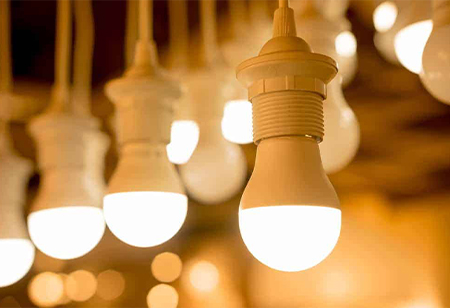
An Ecological LED through a Low-Carbon Route


The global impact of LEDs assures us of a low-carbon economy amid all the concerns we have these days about pollution, energy conservation, and our changing climate. Thanks to its low-carbon emitting technologies, LED lighting solutions lower carbon footprint and emerge as an ecological luminaire that helps in the preservation of our world. A typical lighting system can lose up to 90 percent of its energy as heat. LED lighting, on the other hand, is much more efficient, converting up to 95 percent of its energy into light. LED lights use less energy and produce less heat, which means you won't need extra cooling systems and, in the end, pay less for electricity and reduce carbon emissions.
In light of the regular unusual climatic changes, the Intergovernmental Panel on Climate Change (IPCC) has conducted scientific research and determined that the present global temperature is 1.5 degrees Celsius higher than it was during the pre-industrial era. Thus, it is imperative to consider sustainable energy alternatives.
LEDs make a perfect lighting solution as they can work in challenging conditions as well.
Resistant Against Climatic Conditions
LED lights are the most durable option available. They are perfect for outdoor lighting since they are made of materials that can resist harsh environments. They are immune to tremors, shocks, rain, and wind. They are ideal for outdoor rinks in Canada, a hockey-mad nation because they can tolerate both harsh heat and cold. They are helpful in isolated or rural locations since they can run on low-voltage power with the help of a solar energy source.
But, LED lighting has advantages that go beyond energy economy.
A Safe Option for Human Health too
Hazardous substances like mercury, which can be detrimental to both the environment and human health, are frequently found in conventional lighting systems. At the same time, LED lights don't contain any hazardous materials and are considerably simpler to dispose of properly.
On top of these advantages, research from LightingEurope (produced by the German Electrical and Electronic Manufacturers' Association (ZVEI) and A.T. Kearney) indicates that LED bulbs may offer a number of health advantages. While some of the claims seem a little lightweight, the more credible ones—which are supported by the lights' more realistic light—include:
- Higher focus and drive among staff or students.
- Increased energy and attentiveness.
- "Mood support" in the dining and wellness sections.
- Improved drug efficacy, such as that of antidepressants (in hospitals).
- Shorter therapeutic sessions and less capacity are needed.
Looking at their technology, Sumit Joshi, Vice Chairman and Managing Director - South Asia, Signify Innovations India, in an interaction with CEO Insights magazine, says, “While there are close to 30 billion light points in the world, and while the transition to LED lighting is well advanced, two-thirds of all installed lighting still consist of conventional lighting technology. This shows the significant potential for further reduction of electricity consumption and GHG emissions”.
On the Technology Side
Traditionally, external circuit board drivers have been necessary for LED lighting systems to transform the system's electrical supply into a driving current that can operate the LED and provide stable visible light from the diode.
Latest Technology Interventions
There are exciting new products on the market that make it possible to eliminate external forces from the design process. DC LED chips, which manage all of the LED's power needs directly on the chip, have taken their place. This opens up a world of new product possibilities and more compact packaging. Furthermore, industry-wide, light production in relation to cost keeps rising.
Customizable Beam Control
Recent trade shows have featured new LED systems with dynamic beam spread and no moving parts. This opens doors for applications that need customized beam control.
New Manufacturing Techniques
New manufacturing techniques to create LED arrays that can be used in products are another breakthrough. As an illustration, a research facility in Finland used a roll-to-roll method to produce flexible in-molded LED foil. This accomplishment proves that flexible LED displays with printed circuits can be produced using a roll-to-roll method. Additionally, this could result in a significant cost reduction for this kind of goods.
Li-Fi
Finally, an intriguing new invention is Li-Fi, which is similar to Wi-Fi but uses LED light modulation to create a communication network by turning the light on and off at rapid rates. This has the potential to have a very broad data capacity spectrum, very fast data transmission speeds, and be helpful for communications in electro-magnetic sensitive places. Since this industry's lighting technology is dependent on visible light and cannot go through walls, it was thought that networks of homes and buildings, where networked lighting may be installed throughout rooms, would be the ideal settings for it to operate. Right now, this product is emerging from the research stage.
In the automotive sector, LEDs are becoming more and more prevalent.
Use Case in the Automotive Industry
Any recent auto show worth visiting will show you how fascinating and varied LED-based lighting can be when it comes to both forward and rear lighting, where LEDs are used for both functional effects and style. Similarly, LEDs are now widely used in interior lighting applications, offering the benefits of long life between bulb changes, improved interior space ambiance, and passenger ergonomic safety.
New and fascinating adaptive driving beam headlights in advanced front lighting minimize glare while maximizing driver illumination. Forward-sensing technology is often used to operate an array of LEDs in these systems. To improve driving safety, a microprocessor dims the LEDs in the array that could glare at an approaching car or the car you are following. This keeps the high beams on for the rest of the road. However, these systems are currently in limited use across Europe. Although US industry standards are still being defined, these technologies offer enormous promise going forward.

